Pig-human Hybrids
Pictures
Mammalian Hybrids
EUGENE M. MCCARTHY, PHD GENETICS, ΦΒΚ
Some readers may find the contents of this page disturbing.
|
At night they will think they have seen the sun,
When they see the half pig man: Noise, screams, battles seen fought in the skies. The brute beasts will be heard to speak.
—Nostradamus
Quatrains, 1:64 |
This page collects images of various ostensible pig-human hybrids. Some of the pictures are of recent specimens, others are illustrations from older publications. Taken together, these images provide a good idea of the high level of individual variation seen in this cross.
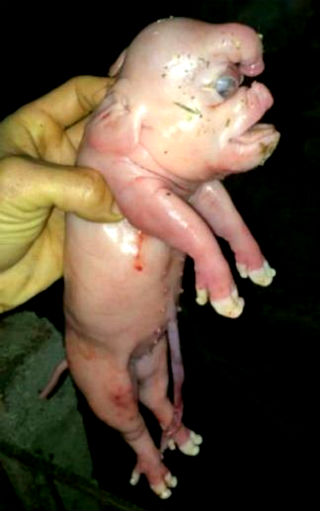
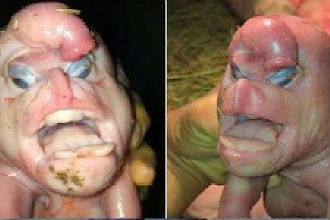 Above: An ostensible pig-human hybrid farrowed on Monday, Feb. 9, 2015 in southern China. A sow belonging to Tao Lu, a resident of Yanan township in the city of Nanning, produced a “piglet” with a human-like face. (Compare with additional specimens below.)
Above: An ostensible pig-human hybrid farrowed on Monday, Feb. 9, 2015 in southern China. A sow belonging to Tao Lu, a resident of Yanan township in the city of Nanning, produced a “piglet” with a human-like face. (Compare with additional specimens below.)
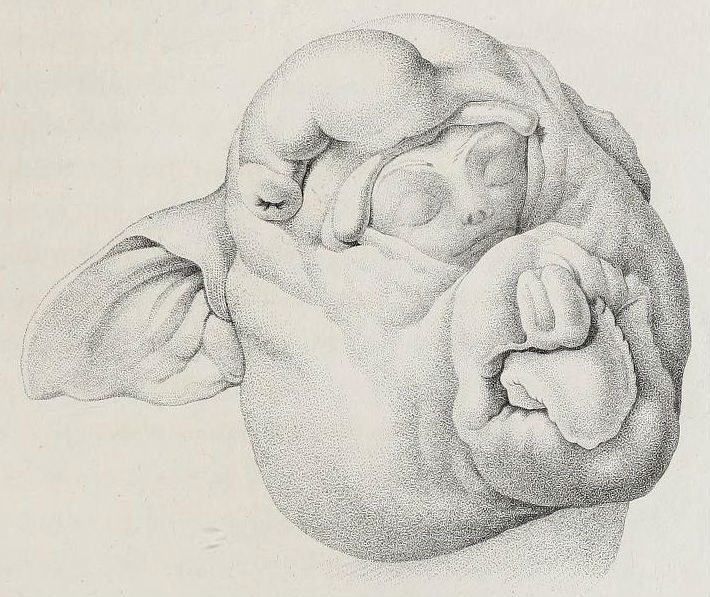 The head of a cyclopean ostensible pig-human hybrid with a frontal proboscis, and a human face on, or in place of, its single eye, as depicted by the German anatomist, physician and artist Carl Gustav Carus. The remainder of this hybrid, which was birthed by a sow, was generally like that of an ordinary pig. Carus states that the appearance of the specimen is “very faithfully represented” (“sehr treu wiedergegeben”) by this illustration (copperplate engraving, source: Acta Academiae Caesareae Leopoldino-Carolinae Germanicae Naturae Curiosorum, 1841, vol. XIX, p. 2, Plate LXXIV).
The head of a cyclopean ostensible pig-human hybrid with a frontal proboscis, and a human face on, or in place of, its single eye, as depicted by the German anatomist, physician and artist Carl Gustav Carus. The remainder of this hybrid, which was birthed by a sow, was generally like that of an ordinary pig. Carus states that the appearance of the specimen is “very faithfully represented” (“sehr treu wiedergegeben”) by this illustration (copperplate engraving, source: Acta Academiae Caesareae Leopoldino-Carolinae Germanicae Naturae Curiosorum, 1841, vol. XIX, p. 2, Plate LXXIV). More information >>
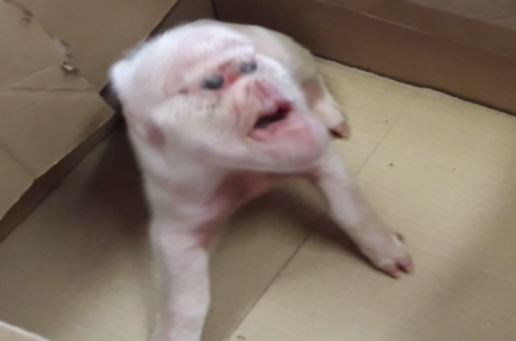
Above: A specimen farrowed in Hungary in August 2018.
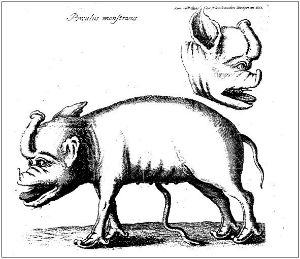
Above: Illustration of a “piglet” farrowed by a sow in Germany in 1751 (from Schreber 1752), which closely resembles the specimen (above) born Feb. 9, 2015, in China. The German individual differed, however, from the Chinese in being asymmetric. Its left ear was like that of a human being (including the presence of an earlobe), while its right was like that of a pig. With regard to the German animal, Schreber (p. 395) also notes that “the tongue is wider than what is usual in a pig, and resembles that of a human being. The eyes stand close together,” he says, “like those of a human being and have the same form, with eyebrows and eyelashes. The head is rounded as in a human.” Note also that the odd curling of the hooves is present in both specimens. The trunk-like process on the forehead is a frontal proboscis (discussed in the main article).
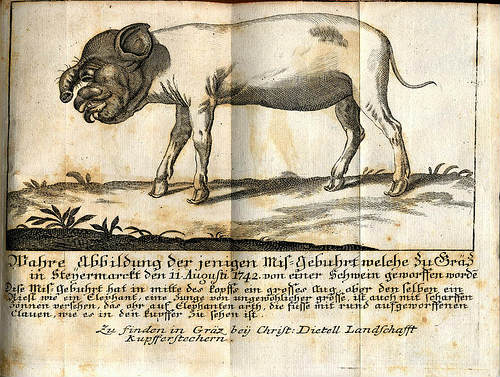
Above: Copperplate depicting another ostensible pig-human hybrid, farrowed by a sow in the cattle market at Graz, Austria, August 11, 1742. Again curling hooves and a frontal proboscis are present. This specimen, however, was a cyclops. (Source).
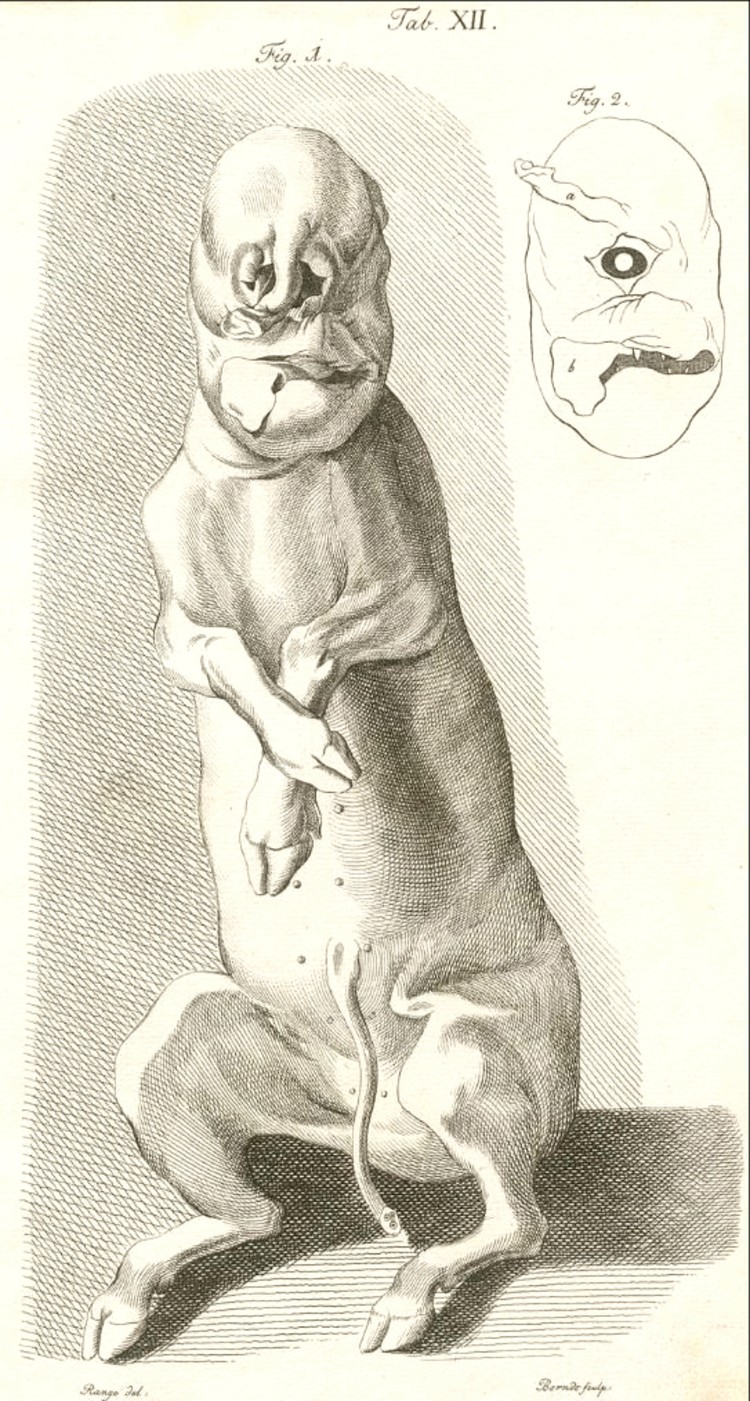
Above: A cyclopian probable pig-human, a female with frontal proboscis, birthed by a sow. Source: Sömmerring (1791, Tafel XII), Abbildungen und Beschreibungen einiger Misgeburten die sich ehemals auf dem Anatomischen Theater zu Cassel befanden, Mainz. Samuel Thomas von Sömmerring (Jan. 28, 1755 – Mar. 2, 1830) was a renowned German anatomist.
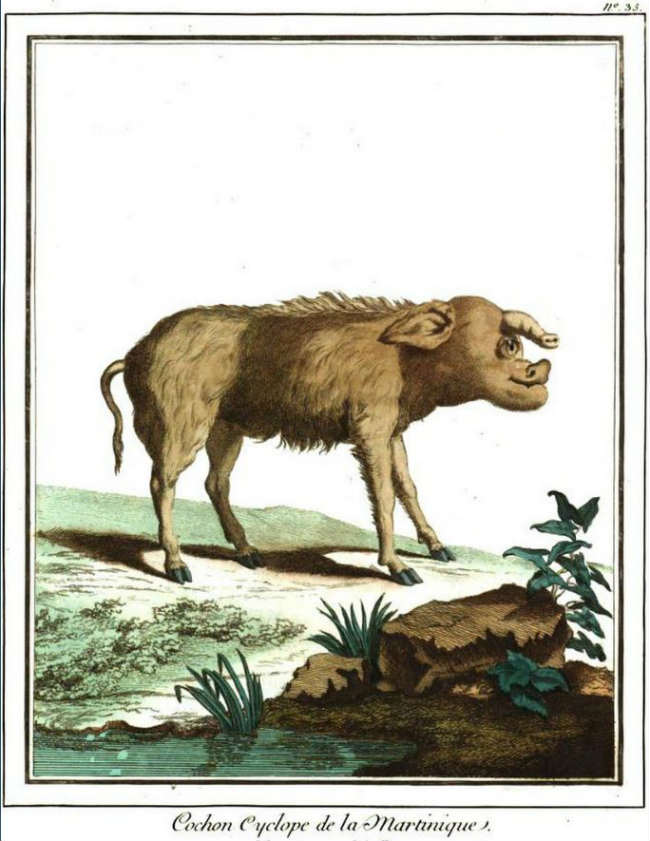
Above: An ostensible pig-human hybrid, a cyclops birthed on the island of Martinique, and at one time (possibly still?) in the collection of the Jardin des Plantes, Paris (Source: Moreau de la Sarthe, 1808). Again a frontal proboscis is present, but the hooves appear to be normal. Note that the ears are directed caudally and are closely adpressed to the neck (an orientation that seems characteristic of hybrids of this type), and not upward as in an ordinary pig.Buffon and Daubenton (Histoire Naturelle, 1766, Tome 14, p. 392) gave a brief anatomical description of this creature.
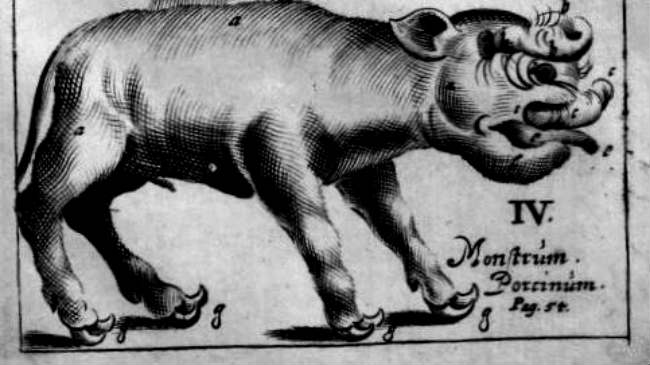
Above: In his Historiarum Anatomicarum Rariorum (Hafniae, 1654, Centuria II, p. 54), the Danish physician Thomas Bartholin (1616-1680) describes another probable pig-human, birthed by a sow at Helsingør, Denmark. Again curling hooves and a frontal proboscis are present. Bartholin describes the eyes as huge and protruding. (Picture shown here is taken from Figure IV, which is between pp. 122 and 123.)
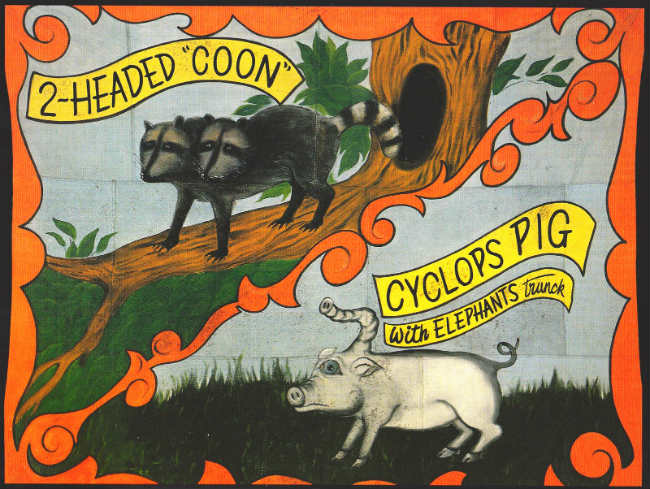
Above: A sideshow ad depicting another cyclops pig with frontal proboscis, a probable human-pig hybrid (circa 1900).
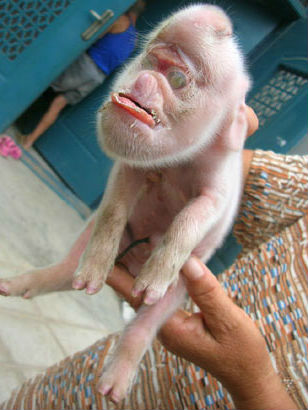
Above: Strange “piglet” born in China in 2008. Note the presence of what appears to be an undetached frontal proboscis.
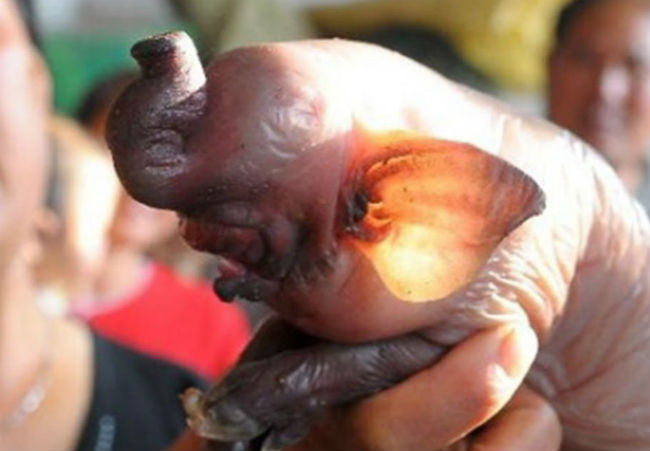
Above: A photo of a 2014 birth with a frontal proboscis and anophthalmia (congenital absence of eyes). Farrowed by a sow, it had curled hooves and caudally directed, adpressed ears, both characteristic of hybrids of this type. Anophthalamia and cyclopia seem to occur at elevated rates in distant hybrids. Born in Jilin in south-eastern China, one of a litter of eight, it had seven ordinary siblings. (Source). Related note: The Roman statesman and historian Dio Cassius (43.2.1) states that at Rome in 46 B.C "a pig was born resembling an elephant save its feet."
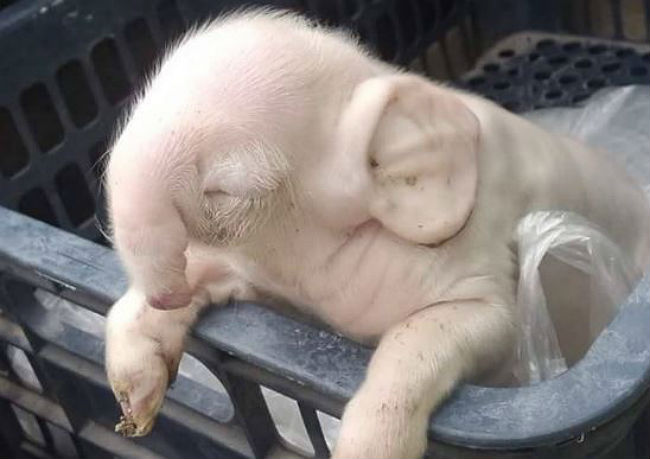
Above: A photo of a 2016 Cambodian birth with a frontal proboscis. It could not open its eyes. Ears are caudally directed and adpressed. This specimen could not eat because it had no mouth, and therefore died two hours after birth (Source).
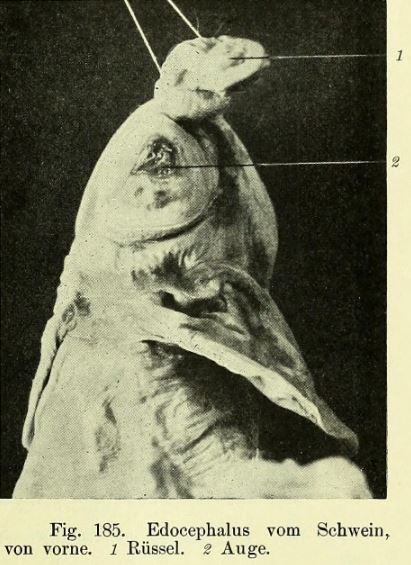
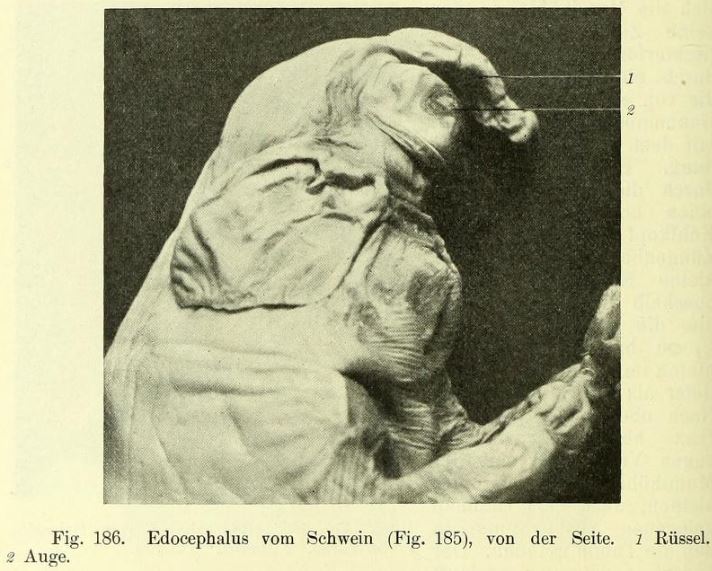 Above: Two views of another probable pig-human (Schwalbe, E. 1906, figs. 185 & 186; ||yxshwjd4). Translation of labelling: Auge = eye; Rüssel = trunk or proboscis.
Above: Two views of another probable pig-human (Schwalbe, E. 1906, figs. 185 & 186; ||yxshwjd4). Translation of labelling: Auge = eye; Rüssel = trunk or proboscis.
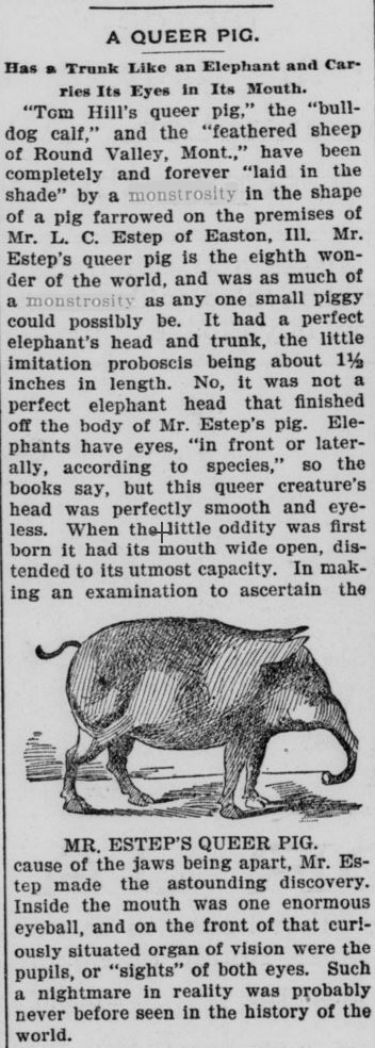
Above: A news story about a piglet similar to the 2014 China birth and to the 2016 Cambodian birth. This piglet had a single eye, with a double pupil, inside its mouth. (Champaign, Illiois, Daily News, Nov. 7, 1896, p. 7, col. 4)
Most shared on Macroevolution.net:
Human Origins: Are we hybrids?
On the Origins of New Forms of Life
Mammalian Hybrids
Cat-rabbit Hybrids: Fact or fiction?
Famous Biologists
Dog-cow Hybrids
Georges Cuvier: A Biography
Prothero: A Rebuttal
Branches of Biology
Dog-fox Hybrids